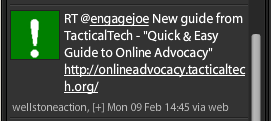I’m delighted to be in Orlando today for a SMUG extension class, presenting a workshop for the Florida Hospital Association’s Florida Society for Healthcare Public Relations & Marketing (FSHPRM) at their Winter professional development workshop. My presentation runs from 12:30-2 EST.
The slides I’m using are embedded below. I’m told there will be wifi in the room, so I’m hoping many of the participants can take the opportunity to add their comments and questions even during the presentation, either in the comment section on this post or by tweeting using the #fhasmug hashtag.
We’ll see if we can address some of the questions and comments at the end of the presentation, but if any SMUGgles are following along remotely and want to chime in with your observations, you’re most welcome to participate.
A Few Resource Links:
- Ed Bennett of the University of Maryland put together this Hospital Social Network List of health care providers and their presence on Facebook, Twitter, YouTube or with blogs. So while health care adoption of social media may have lagged behind other industries — and while the 109 YouTube channels, 73 Facebook pages, 59 Twitter accounts and 14 blogs vary significantly — the fact that Ed has identified 163 hospitals with social media platforms indicates significant progress in adoption.
- Read about Dr. Henry Plummer and his medical innovations, and see a multimedia timeline of Mayo Clinic’s history here.
- For Mayo Clinic examples, see our Facebook page, YouTube channel, News Blog, Podcast Blog, Sharing Mayo Clinic and the blogs on MayoClinic.com.
Homework
Understanding that we likely have a wide range of social media familiarity among the workshop participants, I’ve outlined some options for your concrete action steps to make your the learning practical for you. I’m starting with basics and moving to more complicated or involved steps. Just go down the list and pick at least one thing you haven’t yet tried.
- Join Facebook. Facebook 102 would be a great place to start. You can request to join the FSHPRM group so you can all network and learn together. And of course I hope you’ll join the SMUG group, too.
- Get a Twitter account. Twitter 102 will take you through the process step-by-step. I have a bunch of courses yet to be added in the Twitter curriculum, but there are a few there to get you started, and you can follow me (@LeeAase) and/or @SMUG_U to keep up to date.
- Start a personal blog. Blogging 108 gives you the guidance you need.
- Try Yammer. Yammer is like Twitter for the workplace, and is limited to people who share your email domain. The Yammer curriculum has more background, but Yammer 101 gets you started.
If you’re one of those really risk-averse types who needs to completely scope out a situation before joining, you have two additional options:
- Begin the Core Courses, which are kind of the SMUG appetizer sampler platter. They’ll give you a hands-on taste of social media. Or, you can…
- Start the Podcasting curriculum, which takes you in 10 steps from an introduction to the podcast to having your own personal podcast listed in the iTunes store, all without spending any money. You can complete the first two courses without having to take any concrete action.
Finally, I hope you’ll enroll in SMUG so you can continue your social media exploration as a SMUGgle.
And if you’re on LinkedIn and would like to connect in that way (or perhaps leave a recommendation for me), that would be great, too. Here’s my public profile on LinkedIn.














